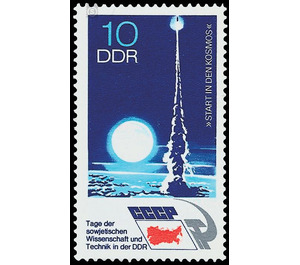Days of Soviet science and technology in the GDR - Germany / German Democratic Republic 1973 - 10 Pfennig
Theme: Post & Philately
| Country | Germany / German Democratic Republic |
| Issue Date | 1973 |
| Face Value | 10.00 |
| Color | blue |
| Perforation | K 14 |
| Printing Type | Rotogravure 2 |
| Stamp Type | Postage stamp |
| Item Type | Stamp |
| Chronological Issue Number | 1629 |
| Chronological Chapter | GER-DDR |
| SID | 638601 |
| In 30 Wishlists | |
Days of Soviet Science and Technology in the GDR During the days of Soviet science and technology in the GDR, the Ministry of Posts and Telecommunications of the German Democratic Republic issued three multicolored special postage stamps. Days of Soviet Science and Technology in the GDR On October 29, 1973, the "Days of Soviet Science and Technology" begin in the GDR. Until 18 November 1973, domestic and foreign visitors will be able to convince themselves of the efficiency and high level of development of Soviet science and technology, giving experts and scientists the opportunity to present and exchange the latest findings in their fields of expertise. Of most interest to the public and the experts at the same time is the exhibition in the capital of the GDR Berlin in the Werner-Seelenbinder-Halle. Here, on nearly 11,000 square meters of exhibition space, top products of the Soviet economy will be on display, a range of exhibits ranging from synthetic diamonds, mechanical engineering and electronics to the mighty spacecraft "Soyuz" 2. 10 Pfennig Value: Launch into the Cosmos In the last two decades of cosmic history, the triumphs of Soviet space travel became a symbol of the scientific and technological progress of the USSR. It was a single-minded road that Soviet cosmonautics, building on the findings of K. E. Ziolkowski, traveled from the launch of the first Sputnik over the great flight of J. Gagarin to the long-term experiment of the "Soyuz" 11 crew. The Soviet space program is characterized by a comprehensive design, a broad scientific and technical base and the systematic fulfillment of all practical steps. On the occasion of the Space Day, which is celebrated annually in honor of the first flight of J. Gagarin on April 12, 1961, aviation cosmonaut Vitaly Sevastyanov declared that the results of cosmos research already bring a high economic benefit: "The demands that are made on the Kosmostechnik are at the same time an impetus for the development of many branches of science and technology. " For example, new heat-resistant materials, superhard metals and nylon-based films have found utility in the economy. Aerospace technology is accelerating miniaturization in electronics and computer construction - direct results of great benefit are provided by Molnija communications satellites for the distribution and transmission of telegraph, television and radio signals; the satellites of the system "Meteor" provide information about global weather situations. An integral part of the Soviet space program is cooperation with the socialist countries. Member States of the CMEA are exploring the cosmic space and the atmosphere, conducting investigations in the field of cosmic biology and medicine and working on problems of radio links and meteorology.


